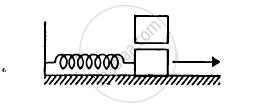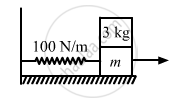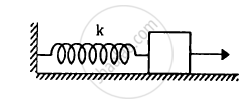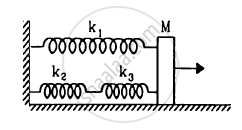Advertisements
Advertisements
प्रश्न
A 1 kg block is executing simple harmonic motion of amplitude 0.1 m on a smooth horizontal surface under the restoring force of a spring of spring constant 100 N/m. A block of mass 3 kg is gently placed on it at the instant it passes through the mean position. Assuming that the two blocks move together, find the frequency and the amplitude of the motion.

उत्तर

It is given that:
Amplitude of simple harmonic motion, x = 0.1 m
Total mass of the system, M = 3 + 1 = 4 kg (when both the blocks move together)
Spring constant, k = 100 N/m
Time period of SHM \[\left( T \right)\] is given by,
\[T = 2\pi\sqrt{\frac{M}{k}}\]
\[\text { On substituting the values of M and k in the bove equation, we have:
\[ T = 2\pi\sqrt{\frac{4}{100}} = \frac{2\pi}{5} s\]
\[\text { Frequency of the motion is given by, }\] \[ \frac{1}{T} = \frac{5}{2\pi} Hz\]
Let v be the velocity of the 1 kg block, at mean position.
\[\text { As kinetic energy is equal to the potential energy, we can write: }\] \[\frac{1}{2}m v^2 = \frac{1}{2}k x^2\]
where x = amplitude = 0.1 m
\[\text { Substituting the value of x in above equation and solving for v, we get: }\]
\[\left( \frac{1}{2} \right) \times \left( 1 \times v^2 \right) = \left( \frac{1}{2} \right) \times 100 \left( 0 . 1 \right)^2 \]
\[ v = 1 {ms}^{- 1} . . . \left( 1 \right)\]
Let V be the velocity of 4 kg block.
Now,
Initial momentum = Final momentum
∴ 1 × v = 4 × V
\[\text { Mean value of kinetic energy is given as, }\]
\[KE \text { at mean position }= \frac{1}{2}M V^2 \]
\[ = \left( \frac{1}{2} \right) \times 4 \times \left( \frac{1}{4} \right)^2 = \frac{1}{2} \times \frac{1}{4} = \frac{1}{8}\]
At the extreme position, the spring-mass system has only potential energy.
\[\therefore \frac{1}{4} = 100 \delta^2 \]
\[ = \delta = \sqrt{\left( \frac{1}{400} \right)}\]
\[ = 0 . 05 \text{ m } = 5 \text{ cm }\]
APPEARS IN
संबंधित प्रश्न
A particle is in linear simple harmonic motion between two points, A and B, 10 cm apart. Take the direction from A to B as the positive direction and give the signs of velocity, acceleration and force on the particle when it is
(a) at the end A,
(b) at the end B,
(c) at the mid-point of AB going towards A,
(d) at 2 cm away from B going towards A,
(e) at 3 cm away from A going towards B, and
(f) at 4 cm away from B going towards A.
A particle executes simple harmonic motion with an amplitude of 10 cm. At what distance from the mean position are the kinetic and potential energies equal?
The equation of motion of a particle started at t = 0 is given by x = 5 sin (20t + π/3), where x is in centimetre and t in second. When does the particle
(a) first come to rest
(b) first have zero acceleration
(c) first have maximum speed?
The block of mass m1 shown in figure is fastened to the spring and the block of mass m2 is placed against it. (a) Find the compression of the spring in the equilibrium position. (b) The blocks are pushed a further distance (2/k) (m1 + m2)g sin θ against the spring and released. Find the position where the two blocks separate. (c) What is the common speed of blocks at the time of separation?

The spring shown in figure is unstretched when a man starts pulling on the cord. The mass of the block is M. If the man exerts a constant force F, find (a) the amplitude and the time period of the motion of the block, (b) the energy stored in the spring when the block passes through the equilibrium position and (c) the kinetic energy of the block at this position.

The springs shown in the figure are all unstretched in the beginning when a man starts pulling the block. The man exerts a constant force F on the block. Find the amplitude and the frequency of the motion of the block.

Solve the previous problem if the pulley has a moment of inertia I about its axis and the string does not slip over it.
Show that for a particle executing simple harmonic motion.
- the average value of kinetic energy is equal to the average value of potential energy.
- average potential energy = average kinetic energy = `1/2` (total energy)
Hint: average kinetic energy = <kinetic energy> = `1/"T" int_0^"T" ("Kinetic energy") "dt"` and
average potential energy = <potential energy> = `1/"T" int_0^"T" ("Potential energy") "dt"`
When the displacement of a particle executing simple harmonic motion is half its amplitude, the ratio of its kinetic energy to potential energy is ______.
If a body is executing simple harmonic motion and its current displacements is `sqrt3/2` times the amplitude from its mean position, then the ratio between potential energy and kinetic energy is:
A body is executing simple harmonic motion with frequency ‘n’, the frequency of its potential energy is ______.
A body is executing simple harmonic motion with frequency ‘n’, the frequency of its potential energy is ______.
A body is executing simple harmonic motion with frequency ‘n’, the frequency of its potential energy is ______.
Motion of an oscillating liquid column in a U-tube is ______.
Displacement versus time curve for a particle executing S.H.M. is shown in figure. Identify the points marked at which (i) velocity of the oscillator is zero, (ii) speed of the oscillator is maximum.

Draw a graph to show the variation of P.E., K.E. and total energy of a simple harmonic oscillator with displacement.
A body of mass m is attached to one end of a massless spring which is suspended vertically from a fixed point. The mass is held in hand so that the spring is neither stretched nor compressed. Suddenly the support of the hand is removed. The lowest position attained by the mass during oscillation is 4 cm below the point, where it was held in hand.
What is the amplitude of oscillation?
